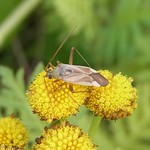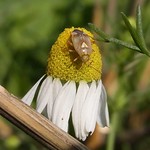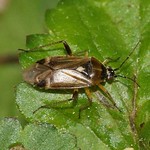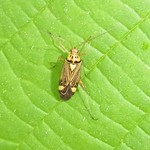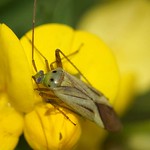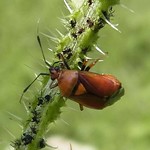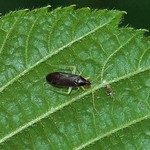Die Weichwanzen sind eine sehr große Familie mit vielen Unterfamilien und Arten. Weltweit kommen rund 10.000 Spezies vor. Circa 1.170 sind in Europa heimisch, in Deutschland und Österreich sind die Weichwanzen mit etwa 400 Arten vertreten. Diese Tiere werden auch als Blindwanzen bezeichnet. Eine ganze Reihe von Mitgliedern dieser Wanzenfamilie konnte ich bisher im Ruhrgebiet beobachten, sie werden in diesem Kapitel in Bildersammlungen gezeigt.
Die folgenden Arten finden Sie auf dieser Seite
- Braunschwarze Nesselweichwanze (Common Brown Nettle Leaf Bug, Plagiognathus arbustorum)
- Eichen-Schmuckwanze (Striped Oak Bug, Rhabdomiris striatellus)
- Frühe Eichen-Weichwanze (Oak Catkin Bug, Harpocera thoracica)
- Gemeine Wiesenwanze (Common Meadow Bug, Lygus pratensis)
- Gemeine Zierwanze (Alfalfa Plant Bug, Adelphocoris lineolatus)
- Gepunktete Nesselwanze (Common Nettle Bug, Liocoris tripustulatus)
- Glatte Grasweichwanze (Common Grass Bug, Stenodema laevigata), wird auch als Glattköpfige Schmalwanze bezeichnet
- Gras-Weichwanze (Grass Bug, Notostira elongata)
- Grüne Distelwanze (Green Thistle Bug, Calocoris affinis)
- Grüne Doldenblütenwanze (Orthops campestris)
- Haselnusswanze (Phylus coryli)
- Langhaarige Dolchwanze (Meadow Plant Bug, Leptopterna dolabrata)
- Prachtwanze (Fine Streaked Bugkin, Miris striatus)
- Rote Weichwanze (Red-spotted Plant Bug, Deraeocoris ruber)
- Vierfleck-Eichenwanze (Four-spotted Oak Bug, Dryophilocoris flavoquadrimaculatus)
- Vierpunktige Zierwanze (Four-dotted Plant Bug, Adelphocoris quadripunctatus)






